***
Jogjakarta trip
Day 1 - 28th April - Walking around Malioboro
AirAsia seems to customize their planes - the one I took to Jogjakarta (henceforth usually shortened as "Jogja") specified what I surmised was the fine for misuse of lifejackets (there was no English translation - perhaps they trust non-Indonesian passengers) in Rupiah. The merchandise was also priced in Rupiah.
On our arrival, there were lots of people take pictures of and filming us. Perhaps it was for a "tourism is going strong despite Swine Flu" or AirAsia promo.
At the airport, I got hit by the airport taxi cartel. I could've taken a bus into town, but this being a Third World country, there were also no maps or tourist information at the airport (or if there was, the counter was unmanned).
Valiantly trying to avoid the taxi cartel, I ignored the taxi driver touts and went up to a guy at one of the airport counters and asked how much a taxi to the city would cost. He deliberated for quite a bit, walked out a bit, was swarmed by taxi drivers and then quoted me 60,000 Rupiah (~S$8). I knew this was a ripoff price, but the heat was delibitating (and the combined wonders of airplane safety and AirAsia meant I hadn't drunk anything since Singapore), so I subjected myself to the indignities of the Third World.
On the way to the hotel, I saw an ad for some place called Hugo's which said they gave free cocktails for ladies in miniskirts.
When I reached the hotel, confused by my dehydration and the number of zeros on the Rupiah notes, I accidentally gave the taxi driver 600,000 Rupiah (~S$80) instead of 60,000. The bastard didn't say anything and drove off, and I only realised my mistake half an hour later when counting my money in the hotel room. Although this was my most serious screwing in the cesspool of corruption that was Indonesia, it was far from my last (it wasn't my first either, that being the initial ripoff by the taxi cartel). In any case, this unearned monetary transfer to a poorer recipient has wiped out my Third World charity budget for some time to come (the definition of charity being the same, at any rate).
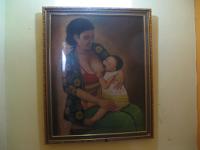
Painting in the hotel. Haram (over the days, I lost track of how many times I said this)!
There're fewer tudung-ed women in Indonesia than Malaysia. This considering that about 88% of Indonesia is Muslim, versus 60% of Malaysia.
There're a lot of KFCs in Jogjakarta. Considering how popular Ayam Goreng is, that is telling (either of how much they love it, or how good KFC in Indonesia is [I didn't try any]).
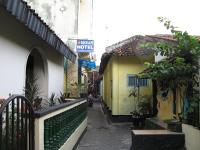
Hotel tucked into an alley (there were a few corners to turn when walking in from the road)
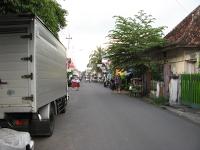

Road outside the hotel. It reminded me of the road outside my Siem Reap hotel than Bolehland. I think it's because both places screamed "tourist trap" and had lots of transport touts (the de rigueur local experience in Jogja is a "becak" - a reverse trishaw).
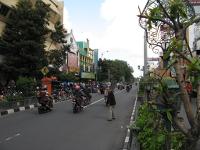
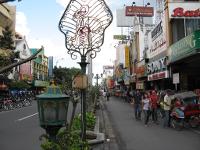
Malioboro. What passes for a main road in the centre of Jogjakarta. Notice the large parallel road for motorsikal parking.
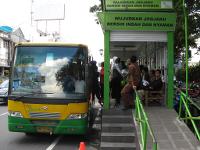
Raised bus platform - how they prevent impromptu stops (at least by buses from this company)? The transJogja bus is one of the few institutionalised things in Jogja - you pay 3000 Rupiah and enter a tiny holding area. You then enter the bus across a raised platform (there's no "mind the gap" warning, though). When there's too many people they sit on the steps (which kind of defeats the point of building such a tiny shelter anyway).
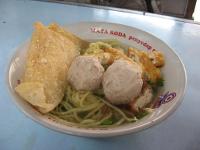
Lunch - Mie Bakso (beefball noodles - they were out of Mie Ayam). This was spectacularly unspectacular, with the soup tasting worse than what you get from an instant noodle packet, which may explain why getting noodles from a packet is so common in Indonesian food outlets.
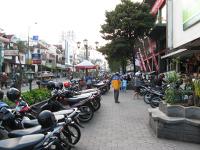
Motorsikal attendant
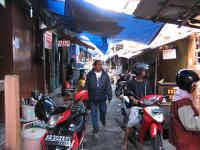

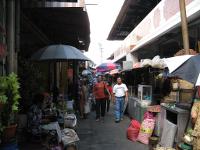
Side alley off Malioboro, which was like a Third World slum. Wait, it *was* a Third World slum.
Near a market in a building, there were a lot of 'beli emas' - small stalls with scales inside a glass box. I assumed they were pawn shops. Given that most people probably didn't have bank accounts, their family heirlooms were probably their means of getting credit.
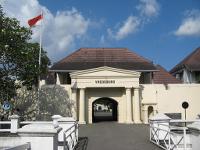
Vredeburg, restored Dutch fort. It was almost 3 by the time I arrived, and in this cesspool the museums only opened in the morning at 8 and closed at 1:30pm (and still closed on Mondays), probably because the attendants spent the afternoons relaxing, making batik or pedalling becaks.
While I was considering my next move, one guy came up to me and started talking to me, dispensing a whole load of advice, among them:
- to avoid the Borobodur and Prambanan "mafias" (I assume he meant monopolies) which had 10x markup
- that most "batik" sold in Jogja was printed
- to smile, laugh and talk more for a longer life
- museum opening times
- the Water Castle was "no water, no castle"
- a recommendation to visit the Jogja Arts Centre (in reality a school, only open to the public 2 days a week) to see Batik-making. I was in luck since this was one of those 2 days
He didn't seem to be trying to get any commission from the last piece of advice, since he didn't lead me there (he said he was waiting for his wife); he was from Kalimantan, and his wife from Sulawesi, so maybe it was only Jogja natives who were so corrupt. Then again, a friend got charged S$18 in Batam for the equivalent of Ang Mo Kio to Orchard.
While walking there, one guy walking in the same direction as me started chatting to me and guided me there (it was neat his house). He said people from the villages were even nicer, but people in Jakarta weren't, as they were obsessed with money. Sadly, these two people were the only nice Indonesias I met in Jogja, so I shall not let two good apples warp my perception of the place.
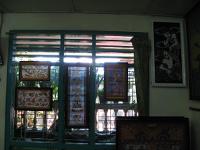
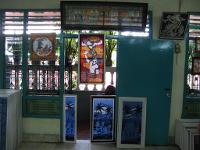
Batik held up to the light
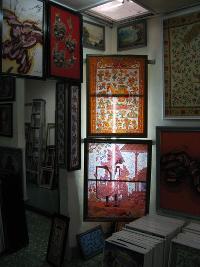
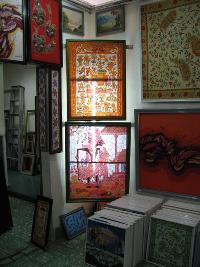
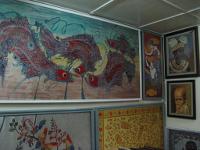
They were quite insistent that real batik could be washed and ironed without running (and demonstrated the former).
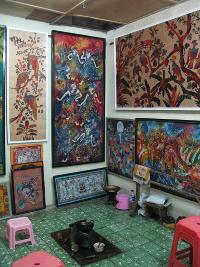
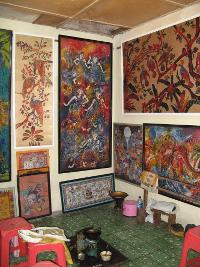
Batik workbench. It takes weeks or months to make, with etching, repeated wax coats and dye jobs - it can only survive where labour is cheap.



Tools and wax

"Batik Art Centre Jogjakarta"
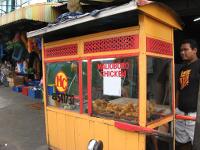
Ayam Goreng vendor: "Malioboro Chicken" (strangely, not along Malioboro but on a street parallel to it). My knowledge of chicken parts started and ended with "ayam", so I pointed to the drumstick ("paha"). Strangely, the price list is facing the vendor, not the customer.
The chicken was good and beat KFC. Perhaps KFC is big in Jogja (and, I assume, Indonesia) for the same reason why Zara, Gap and BMW are seen as high class in Singapore.
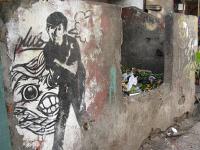
Village midden heap
Travelling band on Malioboro
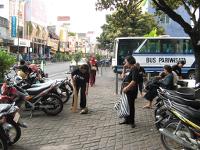
Squad of women sweeping the streets with the crude pseudo-brooms. Elsewhere there were other people doing the same, but these ladies were in uniform and organised like a squad ("Pi2KM").

You can eat anything you want, as long as it's Mie Ayam or Mie Bakso. This was hardly the only scene of identical foodstalls I came across. Sadly, gains from specialisation were not always present.
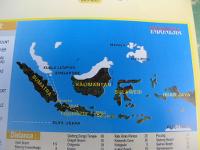
Southeast Asia according to the Indonesians. Indochina is practically gone, the shapes and proportions are all screwy and Singapore is huge (they must be happy we let them launder money through us).
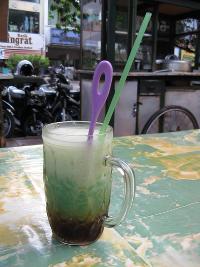
Durian Chendol analogue. Except that it was tepid (not enough es), and the durian seed was huge.
At 4+ many of the hawkers were closing. I thought they were going home to relak, but it turned out they were making way for the night shift (where the food was slightly different).
Luckily, there were *some* stores with fixed prices, which was refreshing after the many ripoff attempts:
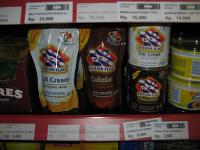
"Frisian Flag". I thought perhaps they hated the Dutch *that* much (Friesche Vlag ["Frisian Flag"] is what Dutch Lady is called in the Netherlands).

More suspicious Indon maps: the "Hindia Ocean"
After I linked up with my travel companion CWN, a "friendly" local cajoled us into visiting a Batik art exhibition, which he said was ending that day. Once we went in, the man in the gallery said it was ending on Saturday (after we told him we were leaving then). In the end, CWN bought one batik piece she liked (I didn't like any, and had bought a small square earlier anyway).
The gallery man was sympathetic over my being cheated by the taxi driver, and said I wasn't the only foreigner to be confused by the zeros. He also said the old 10,000 and new 100,000 notes looked similar, which was a great cockup.
We then went down to a theatre near the Kraton (palace) to watch wayang kulit. The show wasn't scheduled to start yet, so we were (of course) ushered aside to look at wayang kulit puppets (and, naturally, invited to buy them - we demurred).


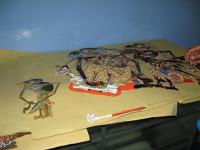

"Civilizations fall when they spend too much time decorating the surface of their stuff"
The puppet master said in Bali the noses are flatter. Here they're longer.
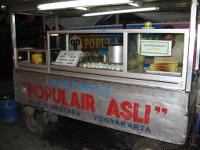
"Populair Martabak", ironically had almost no customers.
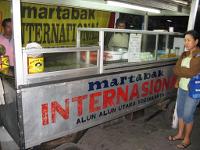
"Internasional Martabak" had more, so we bought from there. The martabak is different from our murtabak, being more like an omelette. Both places also sold "Terang Bulan" ("crescent moon").
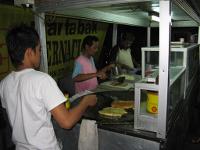
Making Martabak by shallow frying it
While sitting on the denuded grass field in front of the Kraton, CWN observed that the traditional Indon instrument someone was playing sounded like a handphone ringtone
After we finished up our martabak, we were a bit late for the wayang kulit (but as I pointed out, it didn't matter since we wouldn't know what was going on anyway).
I made the startling discovery that wayang kulit was less boring from the wrong side, since you could see the colours and details.


From behind
Wayang Kulit: surtitles would have helped a lot. But at least there was aircon and it was only 20k Rupiah (~S$3) for the performance and 30 cents for a pictures pass - an acceptable price to pay for making observations about why it is a dying artform.
For some reason, diversifying beyond the Ramayana has not occured to Indonesians.
I noted that Wayang Kulit was a very limited art form, with spartan sets, dramatic possibilities largely limited to talking and very limited use of the third dimension. CWN said this performer was lousy as he couldn't exploit the third dimension well.
We then walked around the night food stalls.

Indon racism

Menu of one sit-down place. Virtually all had only these things (one or two had satay also). Notice the disgusting-sounding "es tape" - more about that in a future post.

Fanta cough syrup (I think it was supposed to be strawberry). Totally unlike the Fanta tradition of strong and burning drinks at all. No kwalitas (the Indonesian version of "kualit" we saw - apparently "kualitas" is a more common spelling).
Also, it was served at room temperature, like most soft drinks in Indonesia. I don't know - maybe they like their Es.

Nasi Gudeg Komplit - rice with jackfruit (the brown thing behind the egg). The dark red thing was, I think, seng gueh (CWN thought it was liquorice).

The most worn-out pair of shoes I'd ever seen
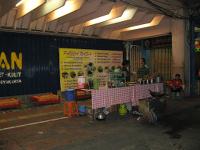
One of the fly-by-night food stalls just setup in the five foot way. They all sell the same food, so I don't know how people choose which one to go to.
Quotes:
[On wayang kulit puppets] Civilizations fall when they spend too much time decorating the surface of their stuff
[Me on Annabel Chong: Be the best in everything.] It's a very Raffles Guy sort of logic.
I can't travel with girls. [Me: Because they are useless] I can't travel with most guys... [Me: They're less useless than the girls, but that's not saying much]
Silkair only flies to places with despotic regimes.
[Me: You want to take bets on who will get food poisoning first?] What's the prize? [Me: Satisfaction]


